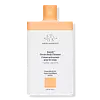What's inside
What's inside
 Key Ingredients
Key Ingredients

No key ingredients
 Benefits
Benefits

 Concerns
Concerns

 Ingredients Side-by-side
Ingredients Side-by-side

Water
Skin ConditioningCocamidopropyl Hydroxysultaine
CleansingSodium Cocoyl Isethionate
CleansingSodium Lauroyl Sarcosinate
CleansingGlycerin
HumectantSodium Chloride
MaskingBetaine
HumectantNiacinamide
SmoothingBrassica Oleracea Acephala Leaf Extract
HumectantCamellia Sinensis Leaf Extract
AntimicrobialChamomilla Recutita Flower Extract
MaskingMedicago Sativa Extract
TonicSpinacia Oleracea
Skin ConditioningAscorbyl Glucoside
AntioxidantHydroxyacetophenone
AntioxidantSodium Hydroxide
BufferingTrisodium Ethylenediamine Disuccinate
Citric Acid
BufferingPanthenol
Skin ConditioningCaprylyl Glycol
EmollientCoconut Acid
CleansingPolyglyceryl-4 Caprate
EmulsifyingQuillaja Saponaria Wood Extract
Skin ConditioningSodium Isethionate
CleansingHexyl Cinnamal
PerfumingLimonene
PerfumingLinalool
PerfumingPhenoxyethanol
PreservativeSodium Benzoate
MaskingParfum
MaskingWater, Cocamidopropyl Hydroxysultaine, Sodium Cocoyl Isethionate, Sodium Lauroyl Sarcosinate, Glycerin, Sodium Chloride, Betaine, Niacinamide, Brassica Oleracea Acephala Leaf Extract, Camellia Sinensis Leaf Extract, Chamomilla Recutita Flower Extract, Medicago Sativa Extract, Spinacia Oleracea, Ascorbyl Glucoside, Hydroxyacetophenone, Sodium Hydroxide, Trisodium Ethylenediamine Disuccinate, Citric Acid, Panthenol, Caprylyl Glycol, Coconut Acid, Polyglyceryl-4 Caprate, Quillaja Saponaria Wood Extract, Sodium Isethionate, Hexyl Cinnamal, Limonene, Linalool, Phenoxyethanol, Sodium Benzoate, Parfum
Water
Skin ConditioningSodium Laurylglucosides Hydroxypropylsulfonate
CleansingCoco-Glucoside
CleansingGlycerin
HumectantCocamidopropyl Betaine
CleansingSodium Methyl Cocoyl Taurate
CleansingSodium Chloride
MaskingSclerocarya Birrea Seed Oil
HumectantCoconut Alkanes
EmollientPassiflora Edulis Seed Oil
EmollientPlukenetia Volubilis Seed Oil
EmollientPrunus Amygdalus Dulcis Oil
Skin ConditioningCaprylic/Capric Triglyceride
MaskingCassia Hydroxypropyltrimonium Chloride
Carbomer
Emulsion StabilisingSodium PCA
HumectantPanthenol
Skin ConditioningGlycol Distearate
EmollientSodium Lactate
BufferingHelianthus Annuus Seed Oil
EmollientGlycine Soja Oil
EmollientPCA
HumectantAlanine
MaskingArginine
MaskingGlycine
BufferingHistidine
HumectantIsoleucine
Skin ConditioningPhenylalanine
MaskingProline
Skin ConditioningSerine
MaskingThreonine
Valine
MaskingCoco-Caprylate/Caprate
EmollientAspartic Acid
MaskingPrunus Amygdalus Dulcis Seed Extract
Skin ConditioningBenzoic Acid
MaskingPhenoxyethanol
PreservativeDehydroacetic Acid
PreservativeSodium Acetate
BufferingWater, Sodium Laurylglucosides Hydroxypropylsulfonate, Coco-Glucoside, Glycerin, Cocamidopropyl Betaine, Sodium Methyl Cocoyl Taurate, Sodium Chloride, Sclerocarya Birrea Seed Oil, Coconut Alkanes, Passiflora Edulis Seed Oil, Plukenetia Volubilis Seed Oil, Prunus Amygdalus Dulcis Oil, Caprylic/Capric Triglyceride, Cassia Hydroxypropyltrimonium Chloride, Carbomer, Sodium PCA, Panthenol, Glycol Distearate, Sodium Lactate, Helianthus Annuus Seed Oil, Glycine Soja Oil, PCA, Alanine, Arginine, Glycine, Histidine, Isoleucine, Phenylalanine, Proline, Serine, Threonine, Valine, Coco-Caprylate/Caprate, Aspartic Acid, Prunus Amygdalus Dulcis Seed Extract, Benzoic Acid, Phenoxyethanol, Dehydroacetic Acid, Sodium Acetate
 Reviews
Reviews

Ingredients Explained
These ingredients are found in both products.
Ingredients higher up in an ingredient list are typically present in a larger amount.
Glycerin is already naturally found in your skin. It helps moisturize and protect your skin.
A study from 2016 found glycerin to be more effective as a humectant than AHAs and hyaluronic acid.
As a humectant, it helps the skin stay hydrated by pulling moisture to your skin. The low molecular weight of glycerin allows it to pull moisture into the deeper layers of your skin.
Hydrated skin improves your skin barrier; Your skin barrier helps protect against irritants and bacteria.
Glycerin has also been found to have antimicrobial and antiviral properties. Due to these properties, glycerin is often used in wound and burn treatments.
In cosmetics, glycerin is usually derived from plants such as soybean or palm. However, it can also be sourced from animals, such as tallow or animal fat.
This ingredient is organic, colorless, odorless, and non-toxic.
Glycerin is the name for this ingredient in American English. British English uses Glycerol/Glycerine.
Learn more about GlycerinPanthenol is a common ingredient that helps hydrate and soothe the skin. It is found naturally in our skin and hair.
There are two forms of panthenol: D and L.
D-panthenol is also known as dexpanthenol. Most cosmetics use dexpanthenol or a mixture of D and L-panthenol.
Panthenol is famous due to its ability to go deeper into the skin's layers. Using this ingredient has numerous pros (and no cons):
Like hyaluronic acid, panthenol is a humectant. Humectants are able to bind and hold large amounts of water to keep skin hydrated.
This ingredient works well for wound healing. It works by increasing tissue in the wound and helps close open wounds.
Once oxidized, panthenol converts to pantothenic acid. Panthothenic acid is found in all living cells.
This ingredient is also referred to as pro-vitamin B5.
Learn more about PanthenolPhenoxyethanol is a preservative that has germicide, antimicrobial, and aromatic properties. Studies show that phenoxyethanol can prevent microbial growth. By itself, it has a scent that is similar to that of a rose.
It's often used in formulations along with Caprylyl Glycol to preserve the shelf life of products.
Chances are, you eat sodium chloride every day. Sodium Chloride is also known as table salt.
This ingredient has many purposes in skincare: thickener, emulsifier, and exfoliator.
You'll most likely find this ingredient in cleansers where it is used to create a gel-like texture. As an emulsifier, it also prevents ingredients from separating.
There is much debate on whether this ingredient is comedogenic. The short answer - comedogenic ratings don't tell the whole story. Learn more about comegodenic ratings here.
The concensus about this ingredient causing acne seems to be divided. Research is needed to understand if this ingredient does cause acne.
Scrubs may use salt as the primary exfoliating ingredient.
Learn more about Sodium ChlorideWater. It's the most common cosmetic ingredient of all. You'll usually see it at the top of ingredient lists, meaning that it makes up the largest part of the product.
So why is it so popular? Water most often acts as a solvent - this means that it helps dissolve other ingredients into the formulation.
You'll also recognize water as that liquid we all need to stay alive. If you see this, drink a glass of water. Stay hydrated!
Learn more about Water